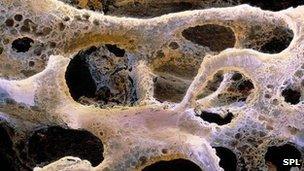Nasa team find 'new way' to spot osteoporosis
- Published

For many people, breaking a bone is their first clue that they have the condition
Nasa scientists believe they have found a way to spot osteoporosis bone loss at the earliest disease stages.
Currently, the condition can go undetected for years and may only be diagnosed with scans after weakening of the bones has led to a fracture.
The new test - designed partly with astronauts in mind as they too can suffer bone loss due to the microgravity of space - looks for traces of bone calcium in the urine.
The work is published in PNAS journal.
The technique developed by scientists at Arizona State University working with the US space agency analyses calcium isotopes - different atoms of the element calcium, derived from bone and each with their own specific number of neutrons.
The balance or abundance of these different isotopes changes when bone is destroyed and formed and can therefore indicate early changes in bone density.
To put it to the test, the researchers studied a dozen healthy volunteers whom they confined to bed rest for 30 days. Prolonged bed rest triggers bone loss.
The technique was able to detect bone loss after as little as one week of bed rest - long before changes in bone density would be detectable on conventional medical scans such as dual-energy X-ray absorptiometry (DXA).
And, unlike other biochemical tests for bone loss that look for blood markers of increased bone turnover, it can give a direct measure of net bone loss.

Weightlessness triggers bone loss
Lead researcher Prof Ariel Anbar said: "The next step is to see if it works as expected in patients with bone-altering diseases. That would open the door to clinical applications."
As well as being useful for diagnosing osteoporosis it could help with monitoring other diseases that affect the bones, including cancer.
Nasa nutritionist Scott Smith said: "Nasa conducted these studies because astronauts in microgravity experience skeletal unloading and suffer bone loss. It's one of the major problems in human spaceflight, and we need to find better ways to monitor and counteract it."
Dr Nicola Peel of the National Osteoporosis Society in the UK said: "It is always exciting to see new techniques being developed with the potential to increase our understanding of the evolution and mechanism of bone disease.
"This approach of using calcium isotopes is very interesting and appears to have potential to detect very early changes of bone loss.
"This could therefore have a future role in the clinical evaluation of patients."
- Published22 June 2011
- Published19 October 2010